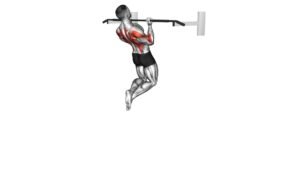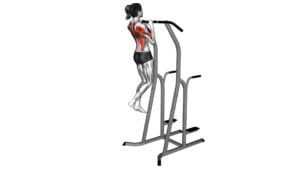Reverse Grip Pull-Up (Female) – Video Exercise Guide & Tips

Looking to strengthen your upper body?
Watch This Exercise Video
In this video exercise guide, we'll show you how to perform reverse grip pull-ups specifically designed for females.
Reverse grip pull-ups target your back, arms, and core, helping you build strength and improve posture.
With proper form and technique, you'll see results in no time.
Watch the video and follow our tips to make the most out of your reverse grip pull-up routine.
Let's get started!
Key Takeaways
- Reverse grip pull-ups target the back, arms, and core muscles.
- Proper form and technique are crucial for maximizing the benefits of reverse grip pull-ups.
- Variations and progressions can be used to increase resistance and challenge muscles in new ways.
- Avoiding common mistakes and incorporating different grip widths can help maximize results.
Benefits of Reverse Grip Pull-Ups for Females
You can experience significant benefits for your upper body strength and back muscles by incorporating reverse grip pull-ups into your fitness routine as a female. Reverse grip pull-ups specifically activate the muscles in your back, shoulders, and arms. When performed correctly, this exercise targets the latissimus dorsi, biceps, and rhomboids, helping to improve overall upper body strength and muscle definition.
Incorporating reverse grip pull-ups into a full body workout routine for women can be highly beneficial. Not only does it target multiple muscle groups, but it also adds variety to your routine, preventing plateau and keeping you motivated. To incorporate reverse grip pull-ups effectively, it's recommended to perform them as part of a comprehensive upper body workout. Combine them with exercises such as push-ups, shoulder presses, and tricep dips to create a well-rounded routine that targets all major muscle groups.
Remember to start with appropriate modifications if you're new to reverse grip pull-ups. Use a resistance band to assist you or perform negative reps by slowly lowering yourself down from the top position. Gradually increase the difficulty as you gain strength and confidence.
Proper Form and Technique for Reverse Grip Pull-Ups
How can you ensure proper form and technique when performing reverse grip pull-ups? Here are some tips to help you achieve optimal results:
- Maintain a strong grip: Ensure that your palms are facing towards you and that your hands are shoulder-width apart on the pull-up bar.
- Engage your back muscles: Focus on contracting your lats (latissimus dorsi) and upper back muscles as you pull yourself up towards the bar.
- Control the movement: Avoid using momentum or swinging your body. Instead, concentrate on a slow and controlled movement both on the way up and the way down.
- Overcome strength limitations: If you find it challenging to perform reverse grip pull-ups due to strength limitations, consider using assistance such as resistance bands or an assisted pull-up machine. Gradually decrease the assistance as you gain strength.
Muscle activation during reverse grip pull-ups primarily targets the lats, biceps, and upper back muscles.
By incorporating proper form and technique, you can maximize the activation of these muscles, leading to increased strength and muscle development.
Additionally, by overcoming strength limitations, you can gradually progress and work towards performing unassisted reverse grip pull-ups.
Remember to listen to your body, start with manageable resistance, and gradually increase the challenge as you become stronger.
Variations and Progressions for Reverse Grip Pull-Ups
To advance your reverse grip pull-up training, try incorporating variations and progressions to challenge your muscles even further.
Reverse grip pull-ups already target the muscles in your back, biceps, and forearms, but by adding variations to your routine, you can engage different muscle groups and increase the difficulty of the exercise.
One variation you can try is the weighted reverse grip pull-up. Simply attach a weight plate or a dumbbell to a weight belt and wear it while performing the exercise. This will increase the resistance and further challenge your muscles.
Another variation is the assisted reverse grip pull-up, where you use a resistance band or an assisted pull-up machine to support some of your body weight. This is particularly useful if you're just starting out or if you want to gradually work your way up to unassisted pull-ups.
As for advanced progressions, you can try the one-arm reverse grip pull-up. This requires immense strength and stability, as you'll be pulling yourself up using only one arm.
You can also experiment with tempo variations, such as performing slow and controlled pull-ups or explosive pull-ups to increase the intensity of the exercise.
Incorporating these reverse grip pull-up variations and advanced progressions into your training routine won't only challenge your muscles in new ways but also help you continuously improve and achieve your fitness goals.
Common Mistakes to Avoid During Reverse Grip Pull-Ups
While incorporating variations and progressions into your reverse grip pull-up routine can be beneficial, it's important to be aware of common mistakes to avoid during the exercise. By avoiding these mistakes, you can prevent injury and ensure that you're getting the most out of your workout.
Here are some common mistakes to watch out for:
- Using momentum: One of the most common mistakes during reverse grip pull-ups is using momentum to swing your body up instead of relying on your muscles. This not only reduces the effectiveness of the exercise but also increases the risk of injury.
- Neglecting proper form: It's crucial to maintain proper form throughout the exercise. This includes keeping your body straight, engaging your core, and fully extending your arms. Neglecting proper form can lead to muscle imbalances and potential injuries.
- Not engaging the right muscles: Reverse grip pull-ups primarily target the back muscles, specifically the latissimus dorsi. It's important to focus on engaging these muscles and avoid relying too much on the biceps or other muscle groups.
- Overtraining: While it's important to challenge yourself, overtraining can lead to muscle imbalances and increased risk of injury. Make sure to give your body enough rest and recovery time between workouts.
Tips for Maximizing Results With Reverse Grip Pull-Ups
To maximize your results with reverse grip pull-ups, incorporate a variety of grip widths into your routine. By changing your grip width, you can target different muscles in your upper body, helping you to maximize your upper body strength. Start by using a wider grip, which will primarily engage your lats, biceps, and upper back muscles. As you become stronger, gradually decrease your grip width to target your biceps and forearms more intensely.
Incorporating reverse grip pull-ups into a full body workout routine can also help you maximize your results. These pull-ups work multiple muscle groups simultaneously, including your back, arms, and core. To create a balanced workout, pair reverse grip pull-ups with exercises that target your chest, shoulders, and lower body. This will ensure that you're working all major muscle groups and promoting overall strength and stability.
To get the most out of your reverse grip pull-ups, focus on proper form and technique. Engage your core, squeeze your shoulder blades together, and pull yourself up using the strength of your back and arms. Avoid swinging or using momentum to complete the exercise, as this can detract from the effectiveness of the movement.
Frequently Asked Questions
How Many Reverse Grip Pull-Ups Should I Do in a Workout?
To determine how many reverse grip pull-ups you should do in a workout, consider your training frequency.
It's important to listen to your body and gradually increase the number of reps as you become stronger.
For advanced workouts, you can incorporate variations of reverse grip pull-ups, such as weighted pull-ups or plyometric pull-ups, to challenge your muscles further.
Remember to maintain proper form and engage your core throughout the exercise.
Can Reverse Grip Pull-Ups Help Me Lose Weight?
Reverse grip pull-ups can be an effective exercise for toning your muscles and burning calories. By incorporating this exercise into your workout routine, you can target your back, biceps, and core muscles.
The reverse grip engages different muscle groups compared to traditional pull-ups, providing a unique challenge and helping you achieve your weight loss goals.
Remember to maintain proper form and gradually increase the number of reps to see the best results.
Are Reverse Grip Pull-Ups Safe for Beginners?
Reverse grip pull-ups can be safe for beginners, but it's important to consider any shoulder injuries you may have. If you have shoulder injuries, it may be best to avoid this exercise or modify it to suit your needs.
There are alternative exercises you can try, such as lat pull-downs or assisted pull-ups, that can still target the same muscles. Always consult with a professional trainer or physical therapist to determine the best options for your specific situation.
How Long Does It Take to See Results From Reverse Grip Pull-Ups?
To see results from reverse grip pull-ups, it depends on various factors, such as your current fitness level and consistency in training.
Reverse grip pull-ups can provide unique benefits compared to regular grip pull-ups. They engage different muscle groups, particularly targeting the biceps, forearms, and upper back.
Incorporating reverse grip pull-ups into your upper body strength training routine can help improve overall strength and muscle definition in these areas.
Remember to start with proper form and gradually increase intensity to avoid injuries.
Can Reverse Grip Pull-Ups Help Improve Posture?
Reverse grip pull-ups are a great exercise for improving posture. By targeting the muscles in your upper body, they help strengthen your back and shoulders, which can lead to better posture. Incorporating reverse grip pull-ups into your workout routine is a smart move for overall upper body strength.
Conclusion
In conclusion, reverse grip pull-ups are a highly beneficial exercise for females, offering a range of advantages such as targeting different muscle groups and increasing upper body strength. By maintaining proper form and technique, individuals can maximize the effectiveness of this exercise.
Additionally, incorporating variations and progressions can help challenge and advance one's fitness level. It's important to avoid common mistakes and follow the provided tips to achieve optimal results with reverse grip pull-ups.

Author
Years ago, the spark of my life’s passion ignited in my mind the moment I stepped into the local gym for the first time. The inaugural bead of perspiration, the initial endeavor, the very first surge of endorphins, and a sense of pride that washed over me post-workout marked the beginning of my deep-seated interest in strength sports, fitness, and sports nutrition. This very curiosity blossomed rapidly into a profound fascination, propelling me to earn a Master’s degree in Physical Education from the Academy of Physical Education in Krakow, followed by a Sports Manager diploma from the Jagiellonian University. My journey of growth led me to gain more specialized qualifications, such as being a certified personal trainer with a focus on sports dietetics, a lifeguard, and an instructor for wellness and corrective gymnastics. Theoretical knowledge paired seamlessly with practical experience, reinforcing my belief that the transformation of individuals under my guidance was also a reflection of my personal growth. This belief holds true even today. Each day, I strive to push the boundaries and explore new realms. These realms gently elevate me to greater heights. The unique combination of passion for my field and the continuous quest for growth fuels my drive to break new ground.







